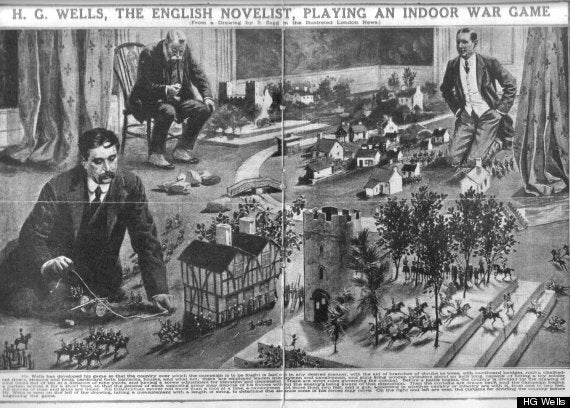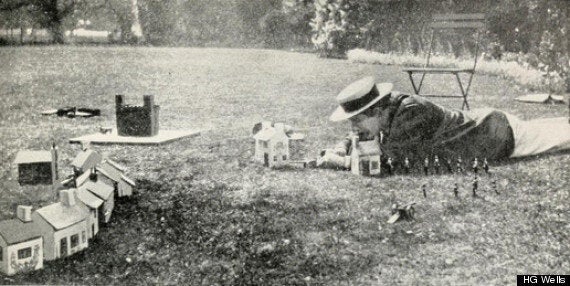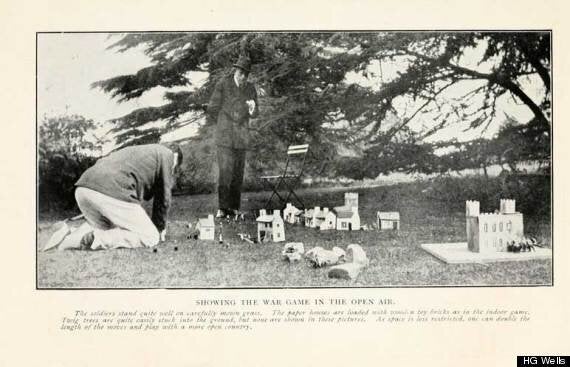In an age of hardcore video games resplendent with controversial violence, it's easy to forget that there was once a time when make-believe war was an analogue experience - and better suited to the tabletop than the screen.
But while you might first think of 'modern' tabletop franchises like Warhammer - and the challenge they face in a world of 3D printers - playing with toy soldiers (digital or physical) has a longer, and richer history.
In fact, this year is its centenary - and you have HG Wells to thank.
In 1913 the English science fiction icon published 'Little Wars', a wonderful handbook for tabletop battle. This year marks 100 years since its first publication, and the 102nd anniversary of 'Floor Games', a preceding volume.

As the first popular handbook for war gaming in the English language of which we're aware (though we look forward to being corrected...) , 'Little Wars' would be an interesting landmark whatever its contents.
As it happens, it is also a delightful read - available online and in several subsequent editions - which also reveals the pacifism at the heart of Wells' thoughts on war. And in a sense, it marks the beginning of a past-time that would lead, eventually, more or less directly to X-Com, Call of Duty, and even Angry Birds.
Admittedly, 'Little Wars' is a product of its time - revealing many of the prejudices that prevailed. For instance, its full title is "Little Wars: a game for boys from twelve years of age to one hundred and fifty and for that more intelligent sort of girl who likes boys' games and books". Not particularly helpful in an age where debates on sexism in games rage more intensely than ever.
In its vision of war as a fairly genteel affair, one of cavalry charges, infantry movements and light artillery taking pot-shots, it also stands in contrast to the horror of trench warfare that would blight Europe shortly after its publication.
As a game too, it's a relatively simple affair. Wells describes how the game was developed with his friend Jerome K. Jerome, while shooting at toy soldiers with a little cannon after dinner one night. The eventual result was a game involving rules for deployment, combat, movement and objectives that he describes in full in the book. But the central mechanics are simple - and not surprisingly, aimed at children. There is no random element in combat, for instance. In the boot Wells talks about starting off with a coin-flip element, but stopping after one soldier won 20 battles in a row. Lucky fellow.

But the heart of the project is arguably Wells' prose, which is enthusiastic and playful in a manner you might not expect from a book more than a century old.
The result is a celebration of gaming - and war gaming in particular - as much as his own particular rules.
In one memorable passage wells describes how "much better is this amiable miniature [war] than the real thing".
"Here is a homeopathic remedy for the imaginative strategist. Here is the pre-meditation, the thrill, the strain of accumulating victory or disaster and no smashed nor sanguinary bodies, no shattered fine buildings nor devastated country sides, no petty cruelties, none of that awful universal boredom and embitterment, that tiresome delay or stoppage or embarrassment of every gracious, bold, sweet, and charming thing, that we who are old enough to remember a real modern war know to be the reality of belligerence."
- a refrain echoed by modern video gamers ever since: playing at violence doesn't necessarily lead to violence in the real world.
In another section - 'the Battle of Hook Farm' - Wells describes one example conflict with all the joy and despair of a contemporary newspaper report - starting with the transformation of the author into the 'gamer' recognisable from so many Call of Duty tournament videos.
"And suddenly your author changes. He changes into what perhaps he might have been under different circumstances. His inky ringers become large, manly hands, his drooping scholastic back stiffens, his elbows go out, his etiolated complexion corrugates and darkens, his moustaches increase and grow and spread, and curl up horribly ; a large, red scar, a sabre cut, grows lurid over one eye.
He expands all over he expands. He clears his throat startlingly, lugs at the still growing ends of his moustache, and says, with just a faint and fading doubt in his voice as to whether he can do it, "Yas, Sir!"

And so it goes on, describing expansion rules, sample scenarios and detailed game mechanics. But behind all of that is something simpler - the joy of gaming, and make-believe, in a world of imaginative violence design to cast light, not darkness, on the reality of warfare.
How to have fun in the garden on a sunny day, basically.
The book is an instructive and funny volume, filled with illustrations and jokes alongside photos of an adult HG Wells playing with toys in the garden. It's available online to read in full - and the first one to hold a tournament (they still happen!) can count on HuffPost attending. Yas, Sir!
